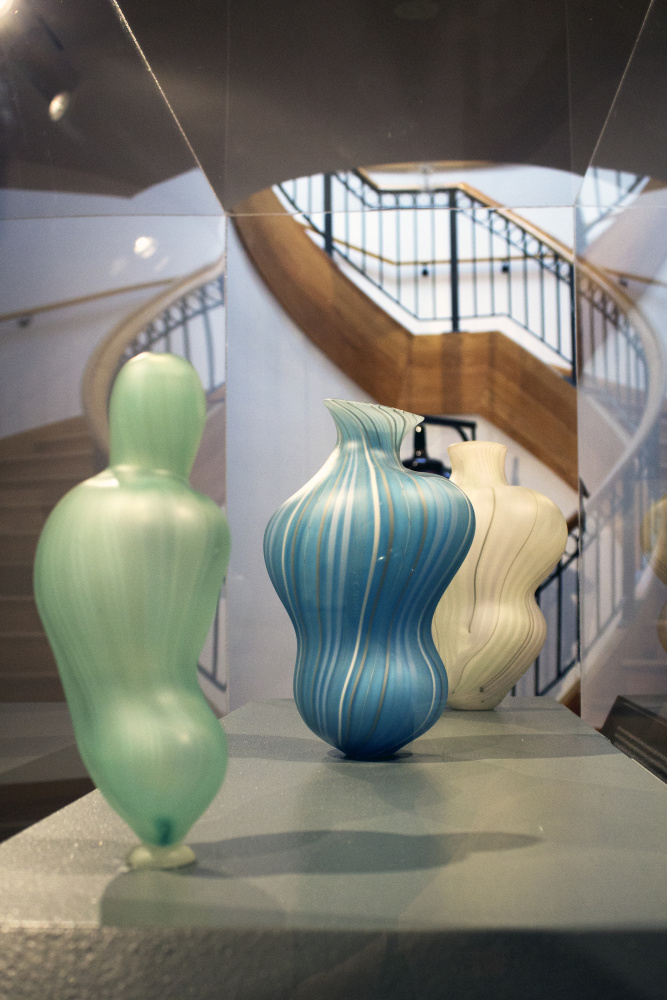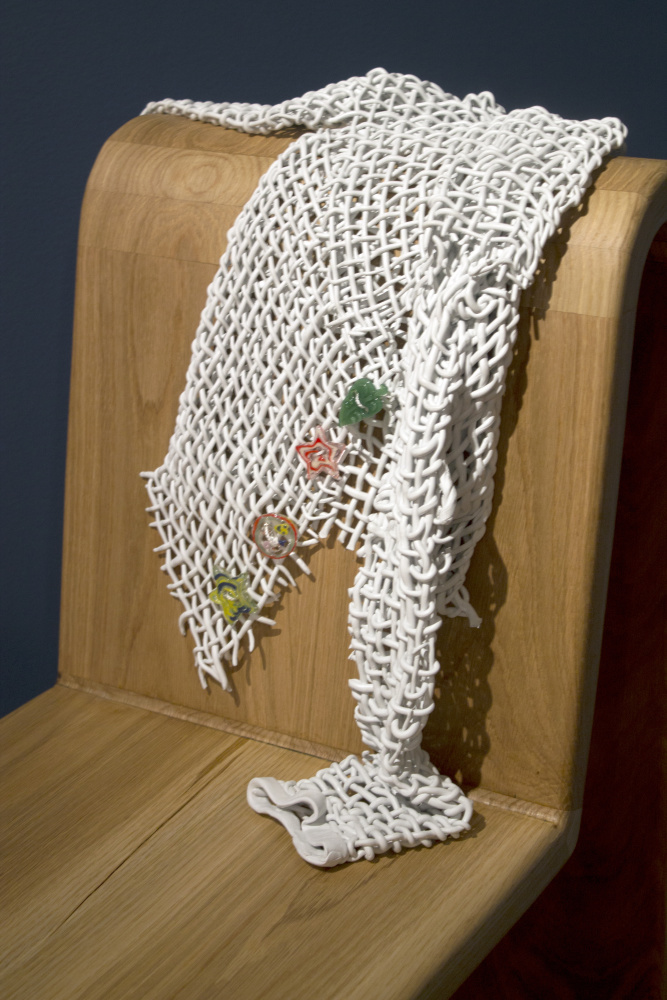- Open today, 10 am to 5 pm.
- Parking & Directions
- Free Admission
Regeneration: Works from the Fall 2020 Glass Studio Assistants
–Katey Murphy, Glass Studio Program Coordinator & Instructor
Much like everything in 2020, the Chrysler Museum Glass Studio’s fall Studio Assistantship session that started in July 2020 was very different. In addition to mastering new techniques, the emerging artists were forced to relearn some old skills such as glassblowing. To prevent the spread of COVID-19, they learned to use compressed air instead of their own breath to inflate the material. They also worked diligently with the Studio team to meet proper sanitation and safety procedures. These artists adapted to a rapidly changing world and navigated how to safely create in a material that is historically community-based.
Since 2011, the Chrysler has eagerly invited talented artists to spend their days at the Perry Glass Studio and Museum to hone their craft and enjoy practical and professional studio experience in a museum setting. Assistants spend six months to a year working with the Glass Studio team and have gone on to graduate school, to work for top glass studios in the country, and start their own businesses. Some have even started their own glass non-profits for outreach. The Glass Studio Assistantship has proven to be a pivotal jumping pad for young artists to develop their artistic voices and skyrocket their careers in glass.

Laura McFie and Becca Low during the virtual performance Passing the Torch. Photo by Julia Rogers.
Each participant joins the program after a competitive international application process. The Studio Assistantship has graduated 128 emerging artists, many of whom come to Norfolk right out of school to learn more about working in a functioning glass studio. In conjunction with working in the Studio, assistants hone their artistic skills, learn new techniques, and research the Museum’s vast collection of glass. At the end of their assistantship, they exhibit works they’ve created during their time in Norfolk.
Every group of assistants creates a different exhibition, working together to find ties in their sometimes very different styles of art. Regeneration is a showcase of the work created by the fall 2020 Studio assistants. For the first time in the history of the program, the Studio assistants were able to install their artwork in the Museum. The exhibition, on view in the Margaret Shepherd Ray Family and Student Gallery, presents ideas of renewal, growth, and reflection, uniquely addressing the issues of our time. Some artists interpreted regeneration in nature, investigating how plants and the ocean renew regularly. Others commented on familial history, ever-changing self-reflection, and contemporary discourse in the age of technology.

Jasmine Steinacker, Inaccessible Gumball Machine
Jasmine Steinacker, whose work often involves food and consumption, uses Inaccessible Gumball Machine to comment on the once harmless apparatus, which has become a trap for disease. One infected hand to the next can no longer reach for the sweet, simple indulgences of everyday life. Dara Roni Alper addresses the rapid changes that have happened in the past year in Disconnect. With glass busts that stare at screens, she acknowledges that, in a technological era, we are individually and collectively coming to terms with a loss of physical community.

Dara Ronli Alper, Disconnect
Other Studio assistants found regeneration in nature. Bioluminescence in the sea served as Kerri Woodard’s inspiration for Sunken Vessels. Frozen in a fluid state, the pieces in Megan Lange’s Pinstriped Bettys appear to be caught in a moment of movement. Michael Mills and Pat Langley took direct inspiration from the wilderness. Still, others embarked on a search for regeneration that led them home. Becca Low and Taylor Cheek reminisce about people and places that represent comfort and a more familiar time before the unprecedented events and circumstances of 2020.

Keri Woodard, Sunken Vessels

Megan Lange, Pinstriped Bettys
While addressing varying themes of regeneration, the Studio assistants exhibit the breadth of material possibilities. Woodard’s Sunken Vessels illuminates the gallery and emphasizes some exciting changes in glass art. She used recently developed glass powders that glow under black light to give the work subtle luminosity that radiates from within. Works by Alper and Steinacker emit their own glow with bent neon and argon tubes that shine brightly across the gallery. Neon art has become an increasingly popular endeavor for many glass artists within the last decade. The material has a rich history, and it is one of the only glass processes that has yet to be modified for mass production, as each tube you see in a neon sign is bent by hand. Alper paired neon with clear flameworked glass in her abstract faces in Disconnect. The glow from the neon and argon tubes creates a refraction of color throughout the work, like a phone screen reflecting onto your face. She learned to bend neon from Glass Studio instructor Matt Jacob, who led a technical session about the basics of neon for the Studio assistants. “I pushed myself technically with this work. The flameworking was hard to evenly bend thin lines and weld the pieces together evenly and smoothly. This is my first neon piece, which unexpectedly broke right before install, but I was able to replace it,” Alper said. Steinacker’s Inaccessible Gumball Machine sits on a bent neon frame. She used traditional glassblowing and the help of other skilled artists to complete the work, which features an oversized blown glass bag filled with glass candies.

Michael Mills, Generative Divergence
Mills and Lange also turned to more traditional glass working techniques for this exhibition, although they execute those methods differently. Mills found inspiration in germination and evolution for his abstracted seed pod, Generative Divergence. Each of the almost sixty pieces of glass that create this form were blown with specific color application in which he uses fine glass frits and powders applied in bits of molten glass to the surface of a clear bubble. These pieces hang on a massive metal armature. Lange’s series, Pinstriped Bettys, uses thin strips of glass color called cane to emphasize the form of each piece. The material represents the human form and our continuous desire to personify objects by giving them attributes such as shoulders, hips, waists, and necks. Each vessel is inspired by dancers in flowing dresses moving through the space.
Several artists brought their ideas of regeneration to life with flameworked glass, a material that is often recognized by its small and intricate details. Low’s cozied up and nowhere to go greets Museum guests with an epoxy/resin clay sweater resting atop a warm white oak chair. Upon closer inspection, the piece displays tiny colorful flameworked glass buttons that evoke memories of Low’s home and her Grandma Pauline. In this work, she reconciles with becoming the sole sentient person in her relationship with her grandmother and pays homage to the lasting impact of watching her work extensively with fiber-based materials.

Becca Low, cozied up and nowhere to go

Pat Langley, Thang #417
Pat Langley invites us to venture outside with Thang #417. Inspired by their time spent in a forest in Northwestern Virginia, Langley uses glass to recreate epiphytes, such as moss, lichen, and fungus. These minute glass pieces sit atop a log in this fantastical scene. A bowl of crystal growing solution rests on one side of the pedestal, and otherworldly blown vessels protrude on the other. The solution will cause crystals to grow on the metal over time, changing this piece during the course of the show. “A lot of my inspiration was from my travels all over the country, observing moss in all regions of the United States, including the Pacific Northwest and the Appalachian Mountains. The live moss that is in the container in this piece is from First Landing. This is more of an overall connection between nature, science, and how humans interact with those things,” Langley said.

Taylor Cheek, Nested in Norfolk
In stark contrast to the color in other works on view, Taylor Cheek uses clear flameworked glass in a process called networking for Nested in Norfolk. Cheek built a web of molten glass into a three-dimensional chicken sitting on its nest, which comments on the rich history of recreating chickens in glass and represents the familial comfort of the artist’s home in rural Ohio.
During the Chrysler’s Studio Assistantship, participants contribute to the Studio’s operations by assisting with public glass demonstrations, public and college classes, and maintenance while honing their artistic skills. Use of the Studio provides a unique opportunity for growth. “Having this time/access to facilities during the pandemic was completely life changing,” Langley said. “My piece would not have been made if I was not here. I would not have had the time, space, or equipment to make this piece without the assistantship.”
Regeneration: Works from the Fall 2020 Glass Studio Assistants is on view through April 1, 2021 in the Margaret Shepherd Ray Family and Student Gallery.
Fall 2020 Studio Assistants
- Keri Woodard / keriart.co
- Megan Lange / meglangestudios.com
- Michael Mills / @mrheymills
- Pat Langley / plangthangs.com
- Taylor Cheek / taylorcheek.com
- Becca Low
- Dara Ronli Alper / daraalper.com / @Dalperarts
- Jasmine Steinacker / @Steinackerart

